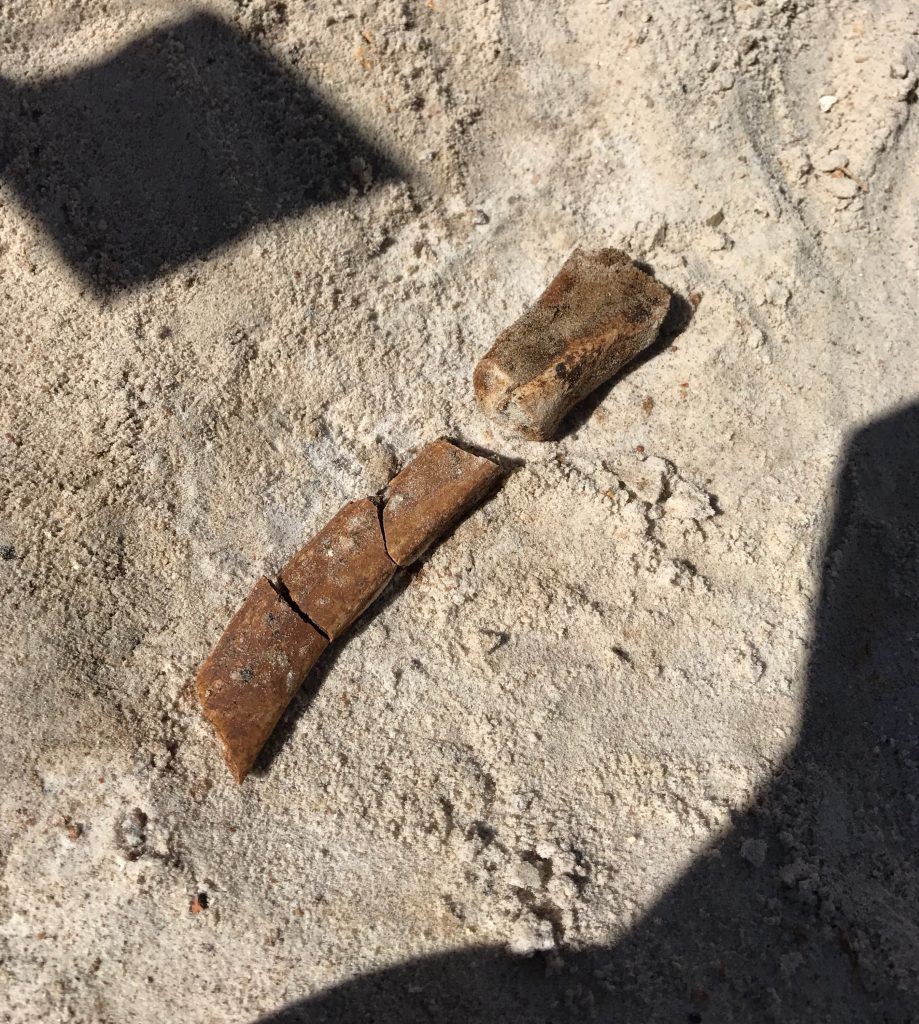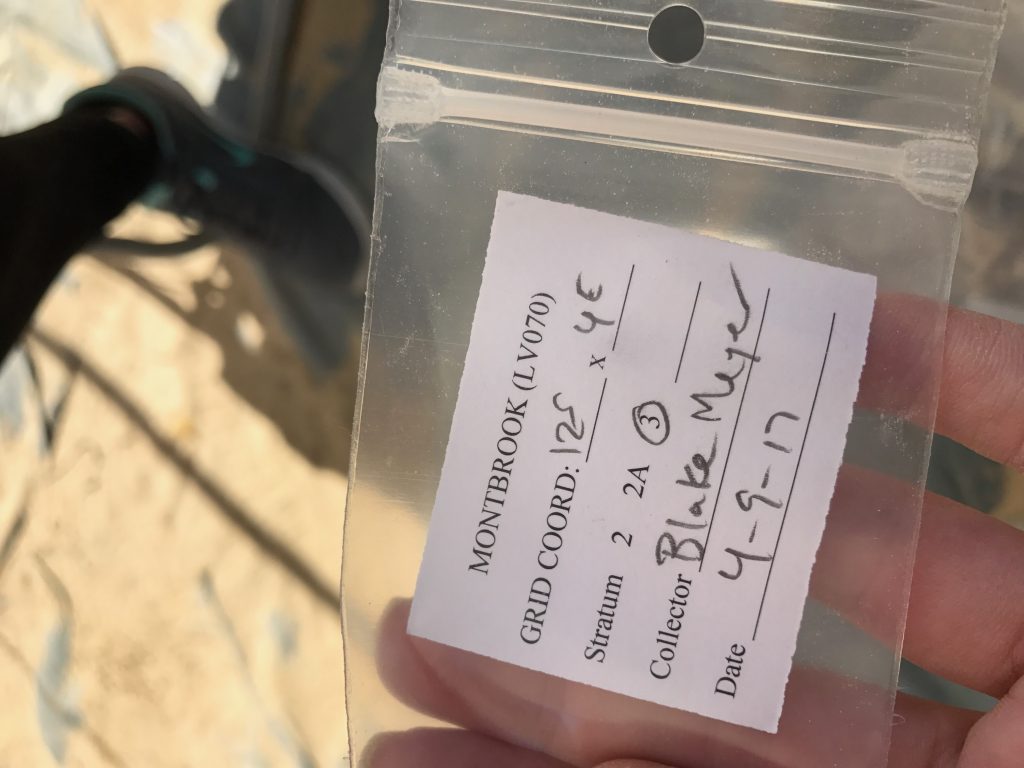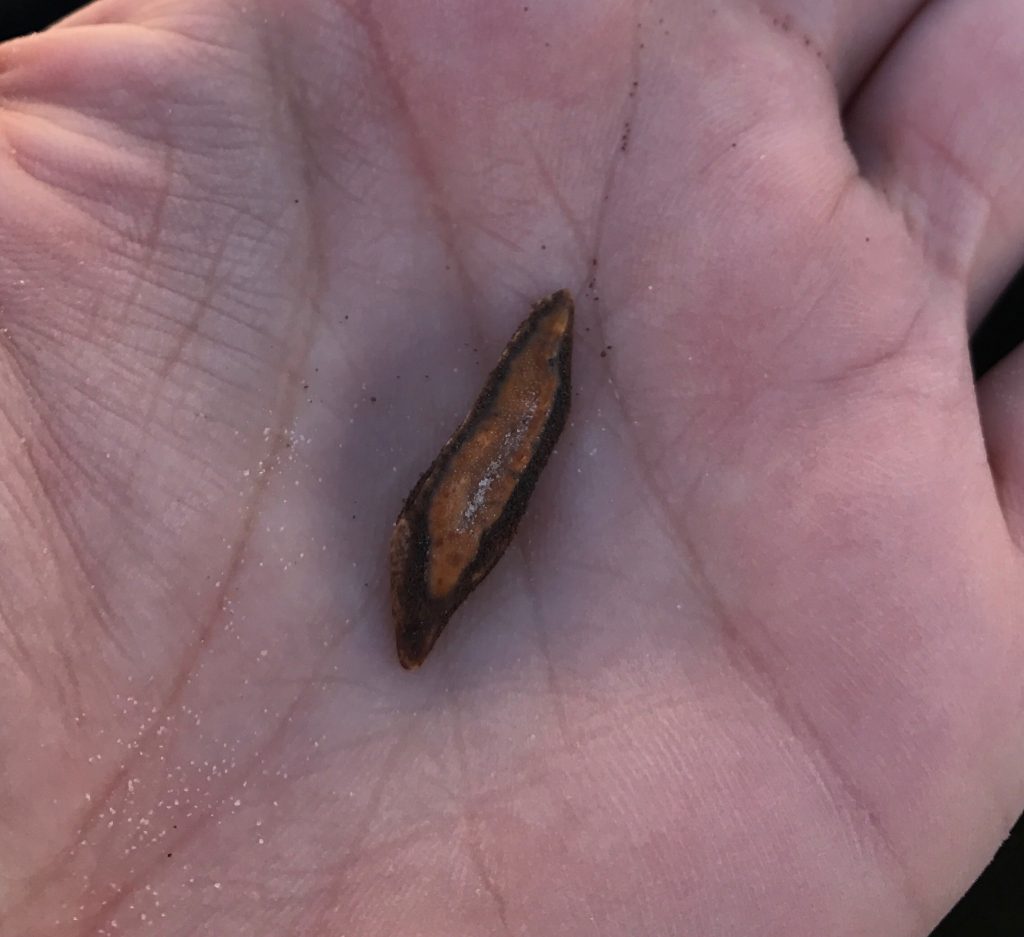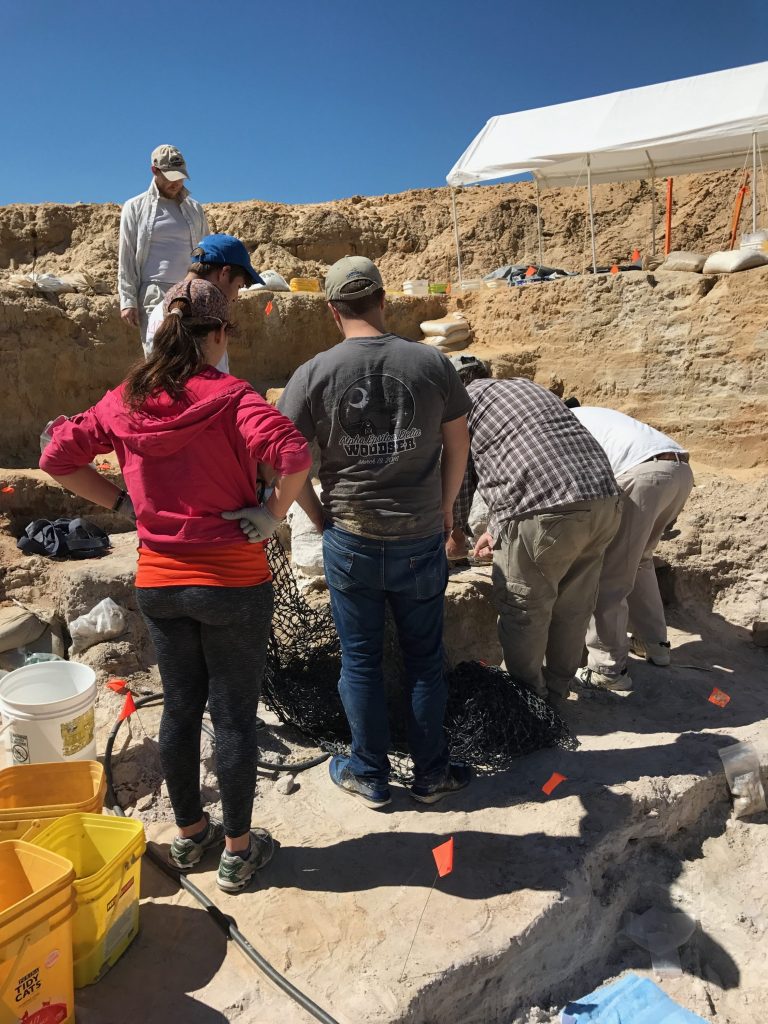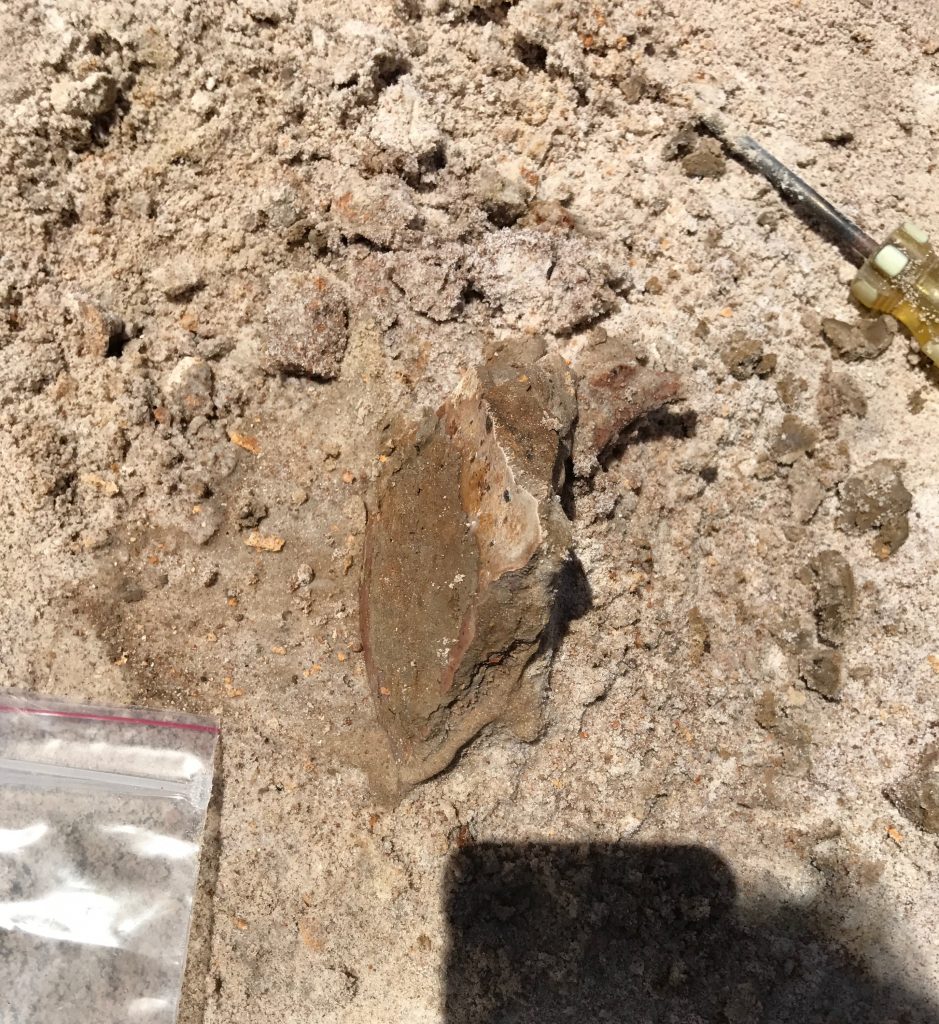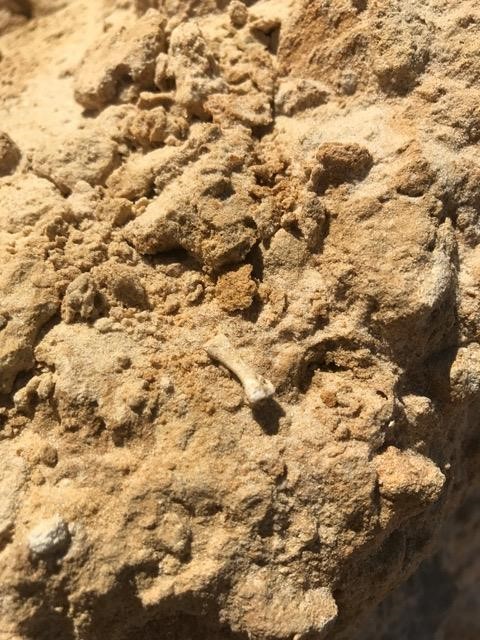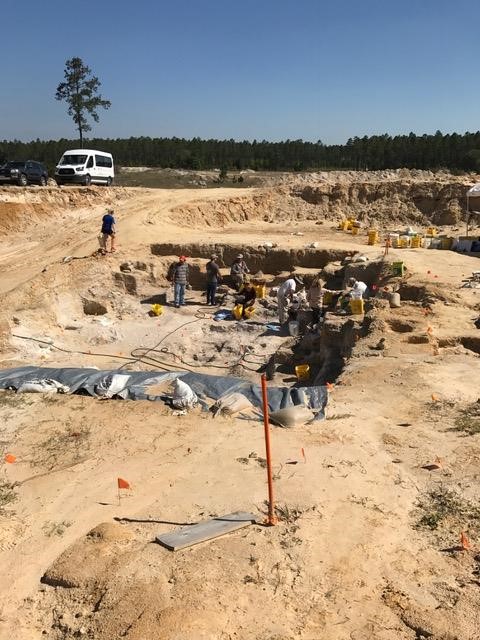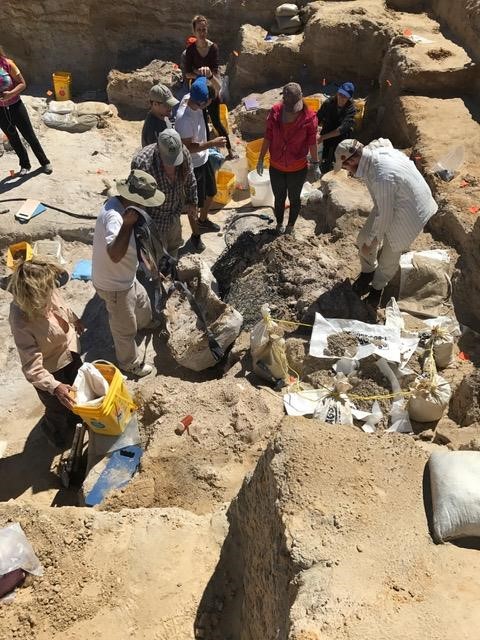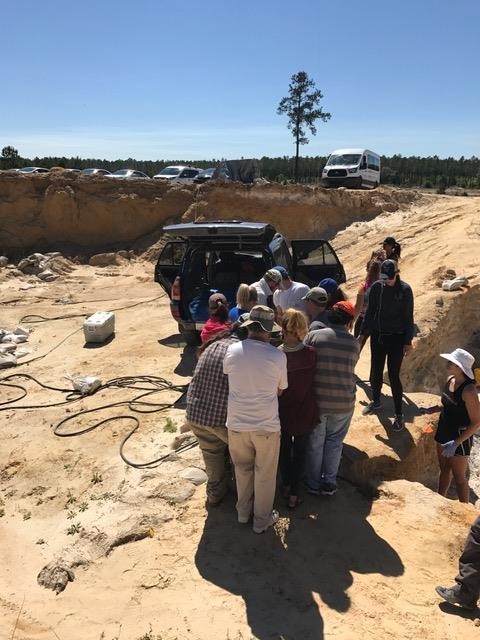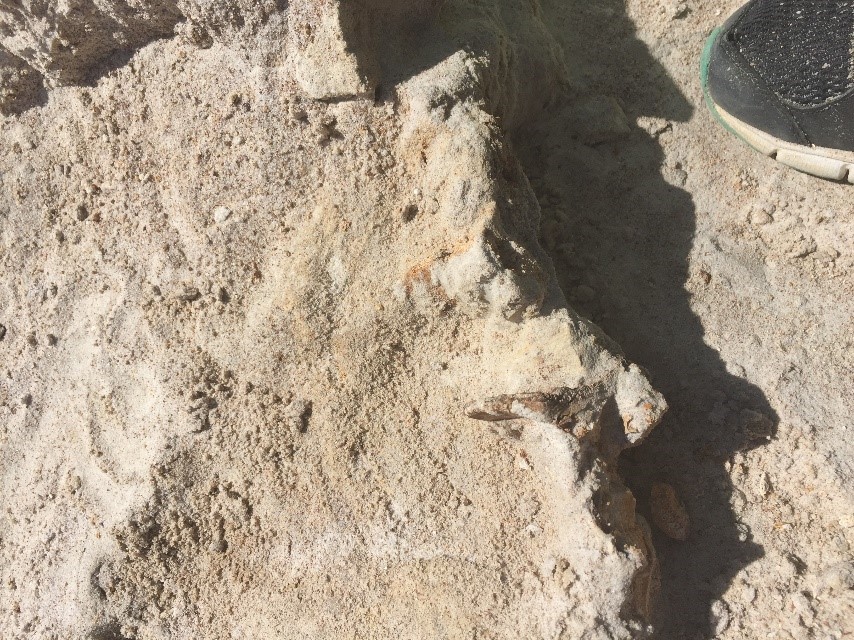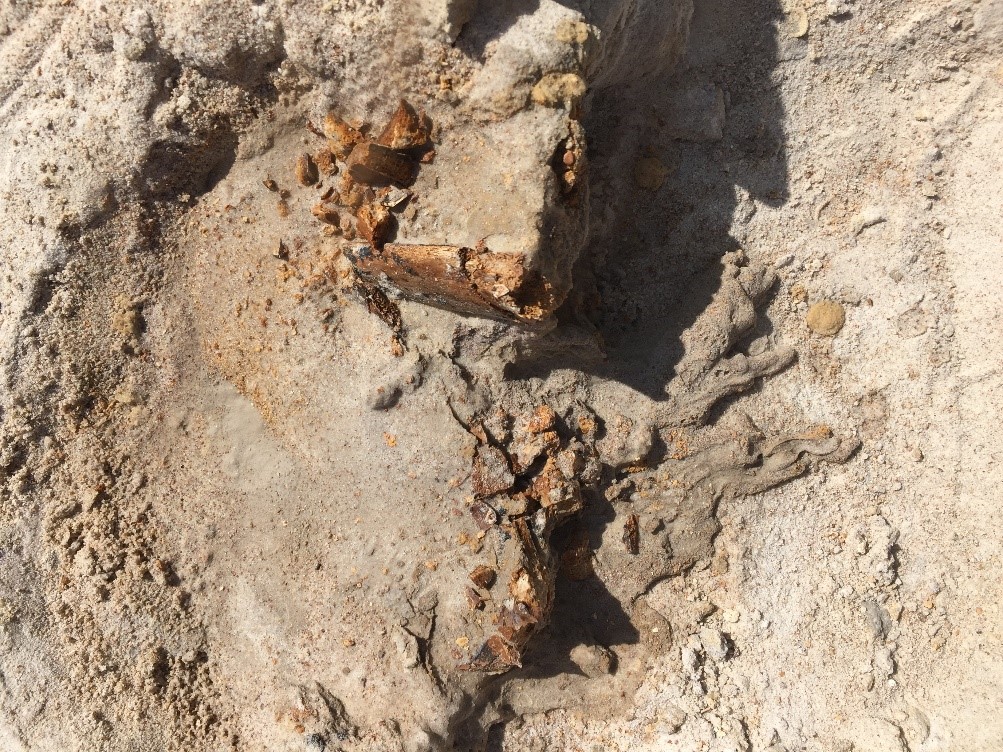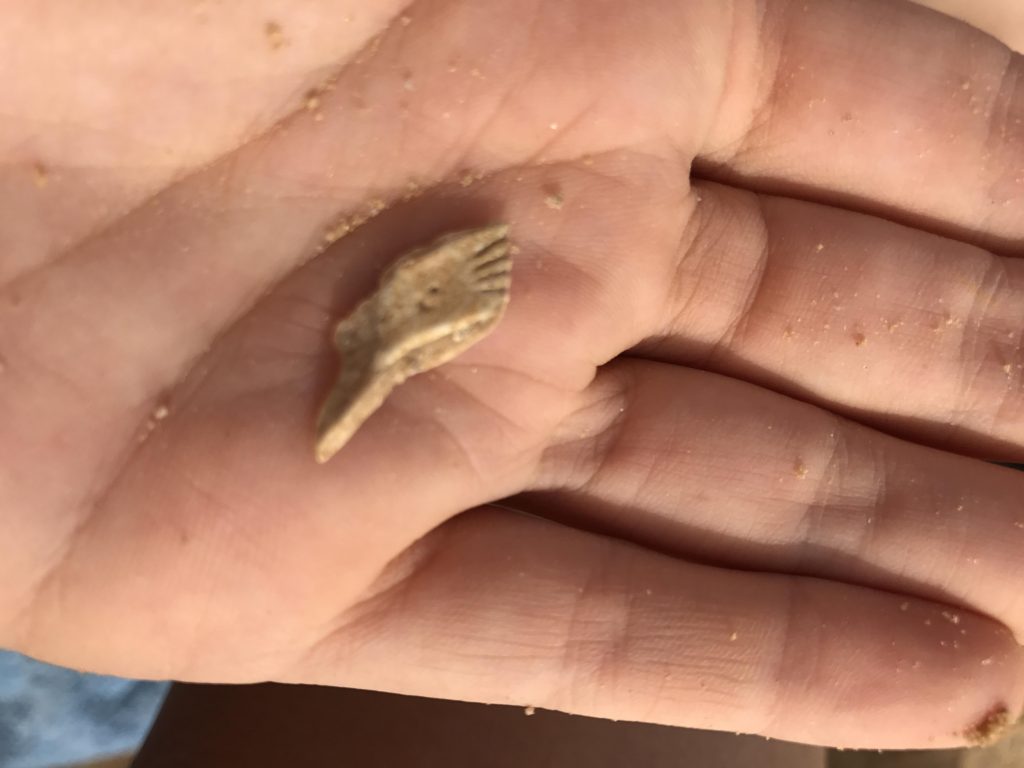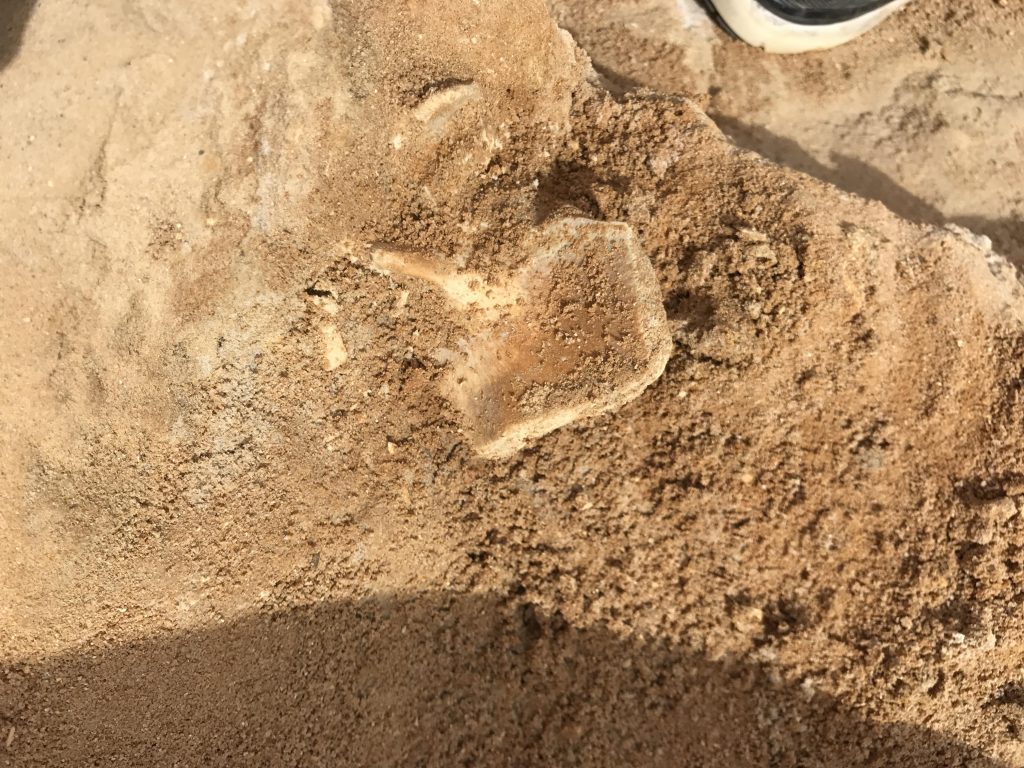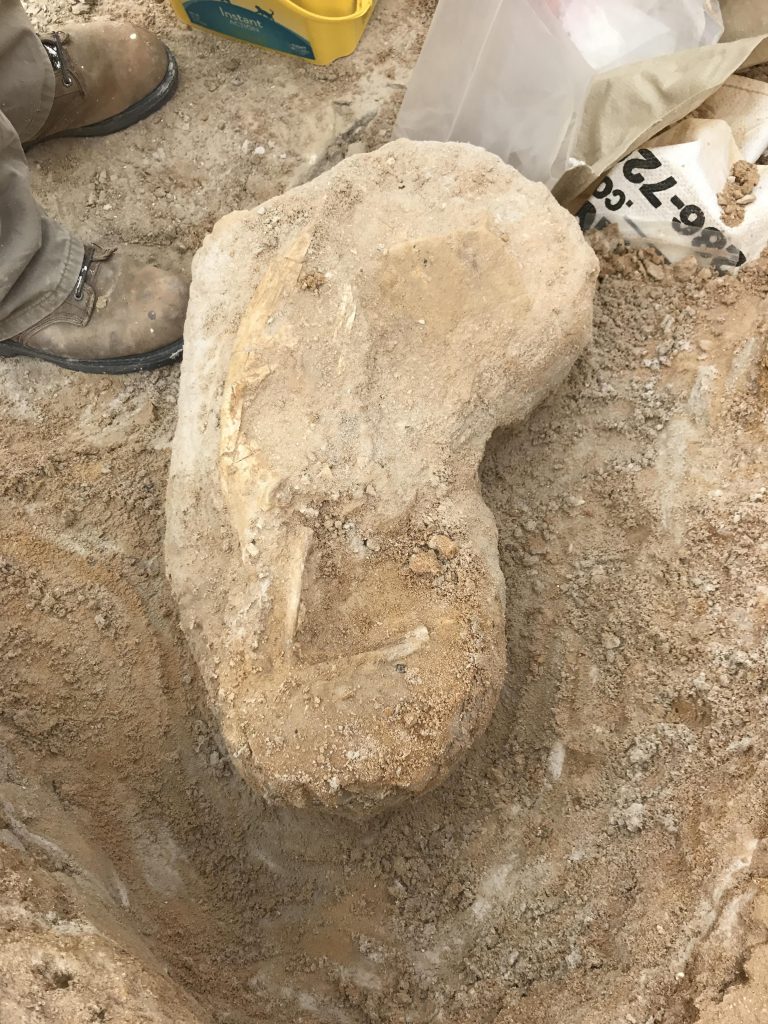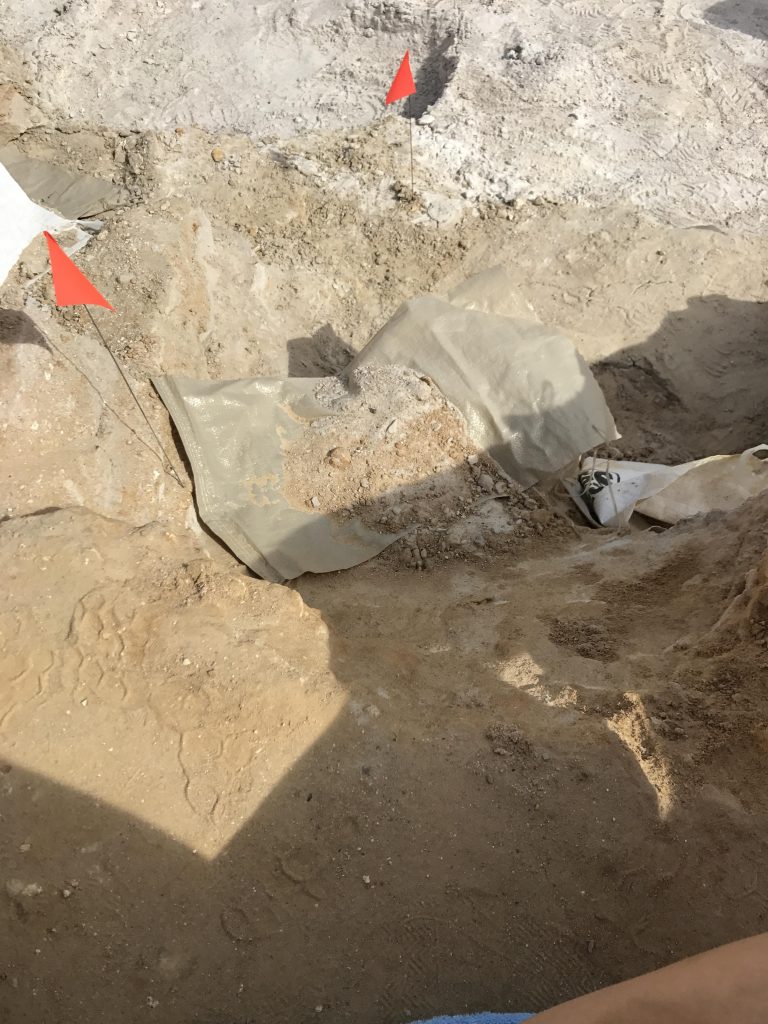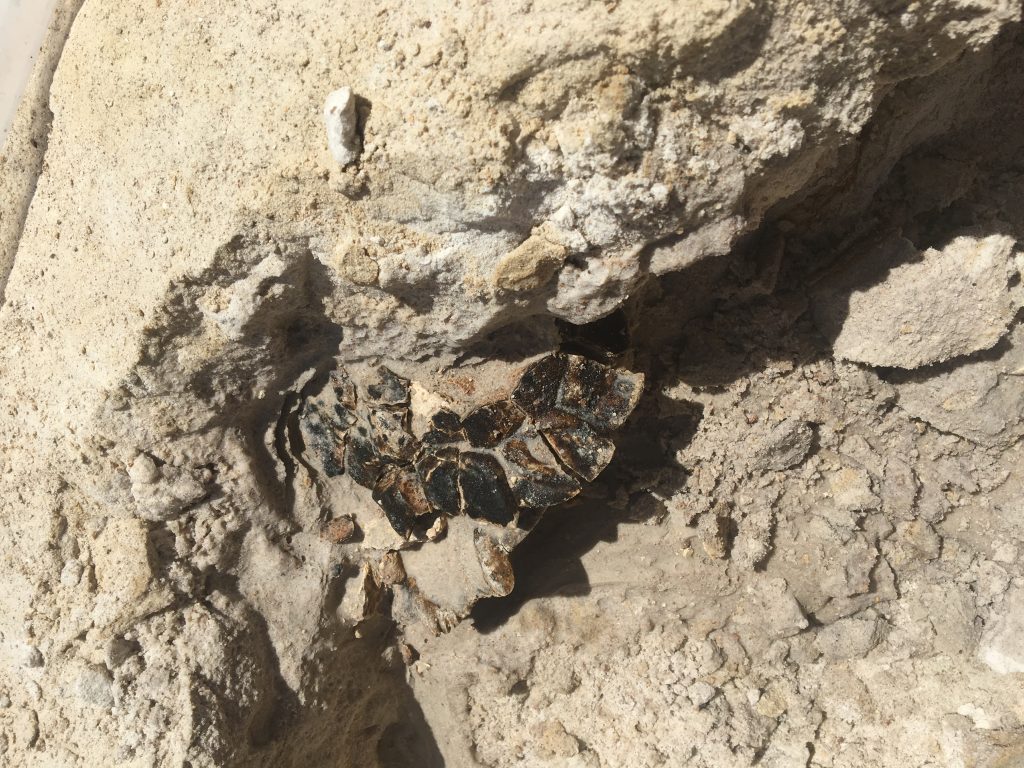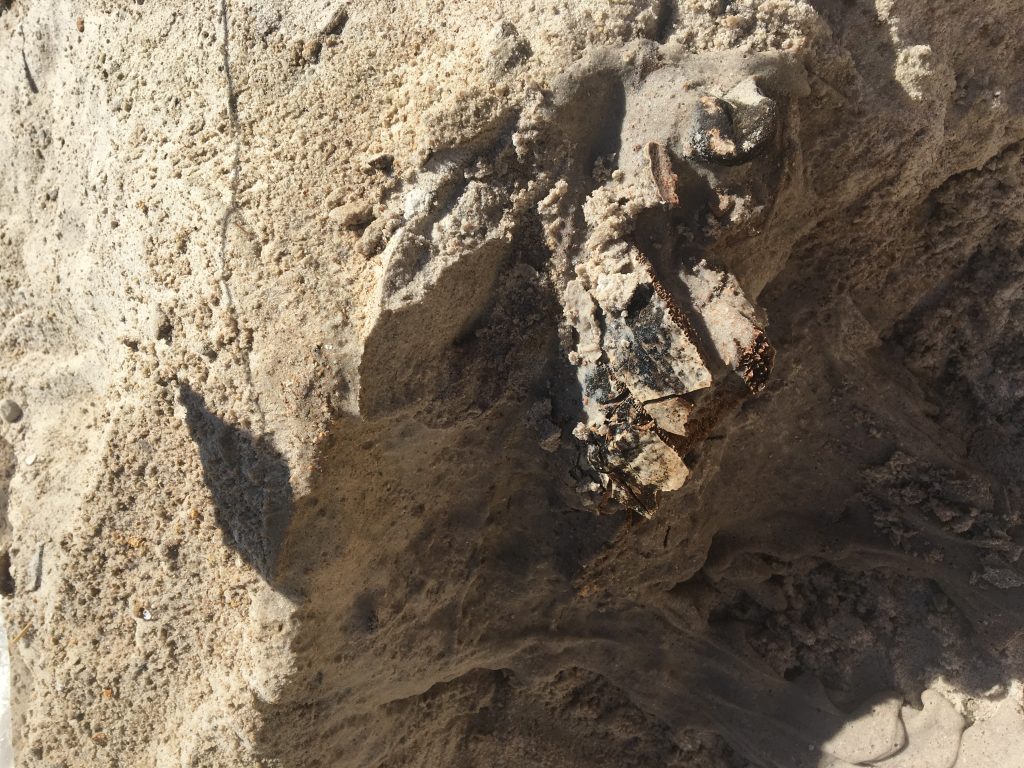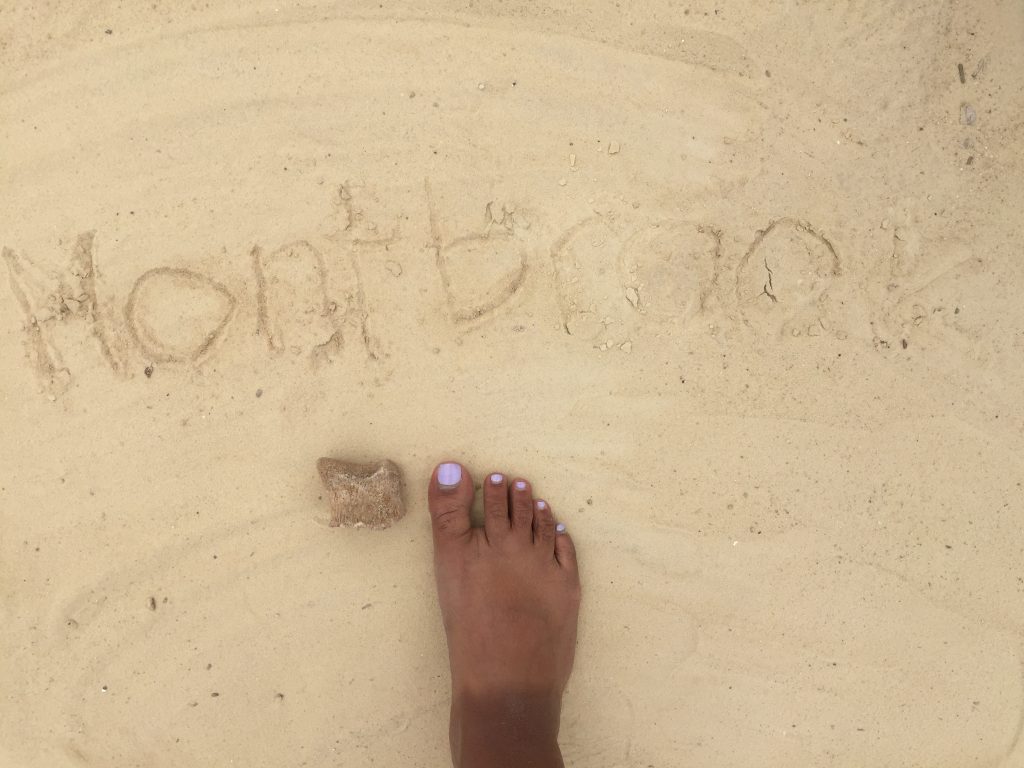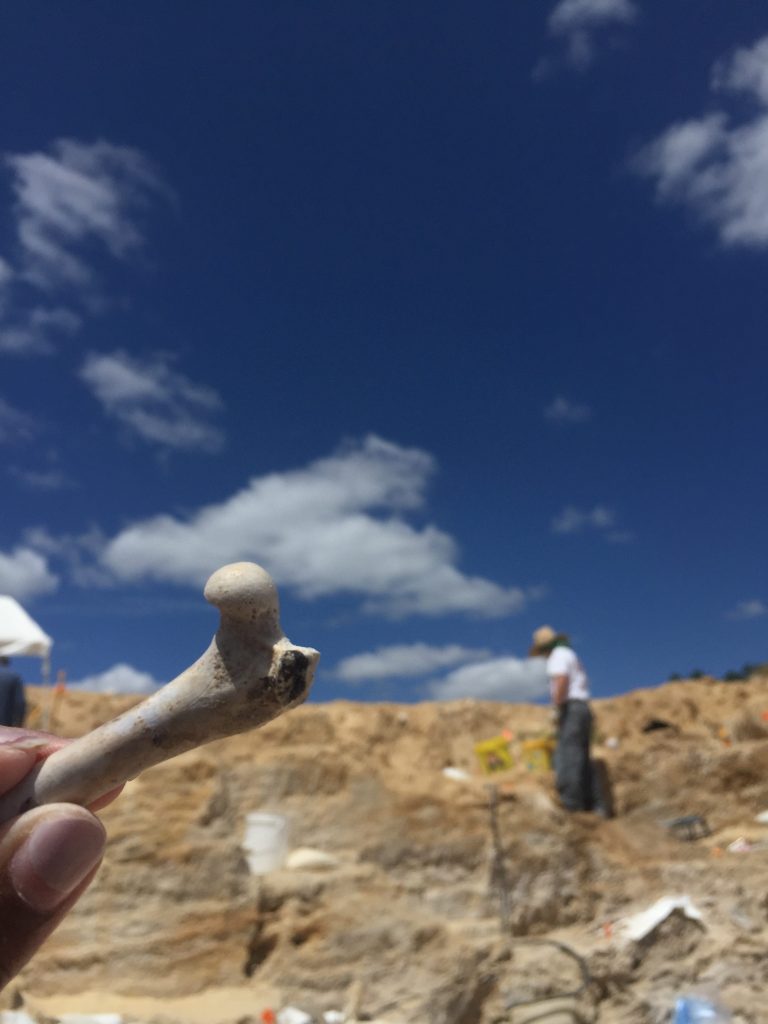Students from the University of Florida, enrolled in the Florida Vertebrate Paleontology Course have been digging at Montbrook all season. Here are their final thoughts on the experience:
“Today was spent lowering the grid to uncover a turtle shell. The shell needed to be further exposed for the dig leaders to decide whether to give the shell a jacket. Digging around it turned up tons of fragments of turtle shells, but the most interesting find of the day was an alligator legbone almost as long as my forearm. When we find larger fossils, we have to dig down to them, rather than around them.Trying to extract it before fully exposing it risks breaking it up into tiny pieces. Even after carefully digging down to it, the leg bone fractured into four pieces when it was removed. I bagged the pieces up, and it will likely be glued back together in the lab.” – Ben Rumsey
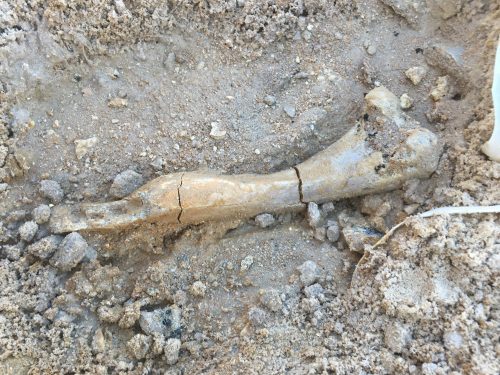
“Today was my final dig day for the semester. Before I touch on my reflection of the semester, I will discuss the day’s findings. It was an average day for me, but it was very, very hot. This was my first day in the lowest level of the site, all the way at the bottom of the giant hole in the ground. I dug up some mammal ribs, gar scales, and plenty of turtle shell pieces as per usual. The most exciting event of the day was the removal of a huge plaster jacket containing an alligator skeleton. The removal took around ten people to manhandle it several feet out of the pit and into a car trunk.
“Just as the day was winding down, I found a very special fossil to me. At the beginning of the semester, I set the goal of finding an alligator osteoderm. Not sure what drew me to this specific bone, but I felt that it was an attainable goal. As I was cleaning up my square to end the day, I saw one more fossil peaking out of the sand. I thought about leaving it there, but instead grabbed it thinking it was another turtle shell remnant. Low and behold, it was an alligator osteoderm, my first and only of the semester. Finding the osteoderm was the perfect end to my Montbrook experience.
“I feel very satisfied with my experience at the Montbrook site. I have learned a lot about paleontology and can even identify some fossils myself now. The experience has been unlike any other, and I am very glad that I have had a small part in this massive and historical dig. Everyone at the site has been very welcoming, kind, and insightful. They will always confirm if you have indeed found a fossil, or simply just a rock, no matter how many times you tirelessly ask them. Dr. Bloch and Dr. Hulbert have created a unique learning environment that I think everyone should experience at least once. Digging for fossils at Montbrook is like fulfilling your treasure hunting and Jurassic Park dreams all at once. Thank you to everyone who has helped me with my digs this semester. I will be passing on the word to everyone I know to come lend a hand at the Montbrook site, as it is an experience you will not want to miss.” – Blake Meyer
“My last dig for my class requirement went by very fast. Thankfully, it seemed to be cooler than last weekend. I was digging a square in the upper sediment near the top of the pit so I got a nice breeze throughout the day. My square had been exposed to the sun for some time so the top layer of sediment was very dry and hard to break through. Underneath the sun-baked top layer, it was mostly sand and some harder chunks of clay. Right off the bat, I found several turtle and fish bones to which I was pleasantly surprised because I wasn’t sure I would find many fossils that close to the top of the pit. In the late morning, we also got to see and help out with taking a plaster jacket out of the pit and loading it up to go back to the lab. In the plaster jacket was an alligator skull and a good portion of the rest of the skeleton. It was incredibly heavy (or so it seemed since obviously my contribution was just taking pictures). During the second half of the day I listened to the Gator baseball game and was surprised how quickly 4pm came. My fossil finding seemed to taper off as I dug but I did find a few fossils that I hadn’t found before. My dig requirement for class is complete but I will most likely continue to volunteer when digging resumes after summer.” – Storm Wittenberg
“This week marks my fifth and final blog week at the dig, although I hope to keep going back as a volunteer. Now that it’s getting hot, though, I might have to stick with partial days for a while. You go through water pretty quickly digging in that kind of heat!
“This time around, my assignment was a spot that didn’t have anything exposed on the surface, but had some turtle shell sticking out right at the edge where it had been found in the next square over. I had to focus on one corner and dig down until I could reach the shell, but we’ll get to that later. My spot hadn’t been worked on in a little while, and had accumulated some loose sand at the top that had blown in from other areas over time, so the first part was pretty easy – I could just scoop out sand with my hands and filter it a bit for any stray fossils as I placed it into my sand bucket.

“As it turned out, there were several small fossils in my spot – both in the looser sand and the more compact dirt underneath. I found gar scales, fish spines and ribs, and fragments that had once belonged to something larger (one of them was identified as coming from part of a gomphothere, which surprised me in the otherwise fish-dominated patch), but nothing particularly large or unusual. One of the fish spines was nicely-sized and well put together, though. You can see that one below.
“It took some time filtering out these fossils and digging my corner down to the necessary area, but eventually I managed to reach the previously-mentioned turtle shell. The bits of bone covered a decent area, and as I started exposing them it seemed like a bit of a confusing mess. Eventually, it reached a point where the exposed portions could simply be sprayed down with a bit of water in order to make what I was uncovering a little more visible.
“The image on the left is the exposed section before it was sprayed, while the right image shows the fossils post hose-down. Though it’s a little hard to see in the picture, it turned out that the bone on the far right was not part of the turtle shell at all – it seemed to be a gomphothere rib. The shell itself was pretty beat up, and a few separate osteoderms were found nearly on top of it to further the confusion, so I spent the rest of the dig exposing what I could of the shell as carefully as I could manage. The tricky maneuvering meant that I wasn’t able to get it out that day, but I did manage to get a good portion of it uncovered.
“I gave myself three goals at the beginning of the semester: To get more involved in taking out the larger fossils, get better at telling fossils apart from ordinary rocks, and find a fossil from a sabre-toothed cat. While I didn’t manage to find any cats (ah well, couldn’t be helped), I most definitely managed the second goal at the very least. The differences between fossil and rock can be subtle at times, and I still have to take some of my finds to the experts, but I’ve definitely improved in picking out some of the tell-tale texture differences. It’s harder to say how well I succeeded at taking out larger fossils, considering I wasn’t closely involved in anything more than helping expose ones large enough to require a plaster jacket, but considering some of my slightly smaller finds like last week’s gomphothere rib, I’d say I managed all right. The hands-on activity of searching out the dig site taught me a lot about how to recognize some of these bones and other hard sections (like scales and spines) as well, especially in turtles and fish!” – Cassandra Schuchart
“My last day at Montbrook was bittersweet. It was an absolutely beautiful day and as soon as I arrived at the site, I knew it was going to be productive as well. I was really excited to get started but I knew it would be my last day with the class so I didn’t want it to end. When I was assigned my square for the day, which was higher in the soil and composed mostly of clay, I was given the task of lowering the square as quickly as possible. In the few days prior to me going out to the site, a major discovery was made. The lower half of an Alligator jaw, the lower jaw of a snapping turtle, and an almost complete soft-shell turtle were all found right next to each other. The plan was to make a plaster jacket for the delicate fossils, but there wasn’t nearly enough room on one side for the plaster because the sediment was to high above it, so I had to lower the sediment in order to reach these fossils.
“While I was digging, I didn’t find much because that sediment, composed mostly of clay, is to high to be rich with the prehistoric specimen. What I did find was multiple pieces of turtle, a shark’s tooth, and a really cool Gar scale. The gar scale was a unique color, so I wasn’t able to identify it as quickly, but I thought it was very cool. In about the last half hour or so of the day, I had lowered the sediment enough to make the jacket. Dr. Bloch prepared the fossils by creating a trench underneath where the jacket would go and covering the fossils in sand to protect them. Once that had been done, a jacket was made and the fossils were removed. Overall, I learned a lot. Not only in that day, but over the past semester in this class. I’m sad it’s over, but hopefully I will be able to return to the site when digging is resumed next fall.” – Nicole Welton
“Today was bittersweet as it was my last day at the dig site. Today I was assigned the task of lowering a square near an exposed Gomphotherium pelvis. I did not find as many fossils today as I was only here for half a day. The fossils I found however were all parts of turtle shells. Overall I felt that this course taught me a lot about not just paleontology, but geology and digging practices. I really enjoyed my time volunteering and would highly recommend this course to anyone who has interested in paleontology.” – Billy Annis
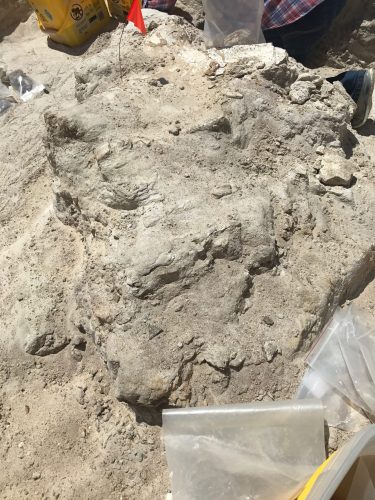
My Final Dig ☹
“I have been begging all of my friends to come dig with me the past few weeks. I just want everyone to experience the satisfaction of making real life discoveries of ancient fossils. To me, it’s 100 percent more exciting than a manufactured experience in a Disney theme park. It is the real deal. My little brother happened to be in town this week, visiting from California. To my surprise, he willingly volunteered to join me Thursday.
“I felt so horrible when he would hand me rocks and clay, and I showed him what it was as I crushed it into sand. However, it did not take long for him to find turtle shells and his first gar scale. He’s not always keen on being out in the hot sun, but I never heard him complain once. He loved it as much as me!
“We did not find anything earth shattering that day, but I was given a tough square that backed up to the wall of the large pit. Rachel warned me it was a tough spot and she was right! I enjoyed working on my techniques of chipping at the sand and using the tools correctly. I was 10x better at telling rocks from bones than when I started. Overall, this was an amazing experience. I wouldn’t trade this class for any other.
“I have walked away with a new respect for paleontologists. It’s a job that requires hard work, extensive knowledge, skilled crafts and an overarching passion for discovery. I look forward to visiting the site in the future and building on the knowledge I gained. Who knows, maybe I’ll find a paleontology class to take in the coming year!” – Alexandra Campione
“Yesterday was my last fossil dig for the semester and it did not disappoint! There were few volunteers this time but that didn’t stop us from making some progess and clearing away some of the plots toward the bottom of the pit. While the day started out slow for me, things picked up as I began to find a few intact turtle shells that I was able to excavate! Unfortunately, the turtle shells were the only thing I found, but I still found it really cool to see the intact shell. Pictured below are some pictures of the shell that I found! Im going to miss coming out here to help look for fossils but I’m happy I was able to get the chance to attend these digs and learn a lot about different fossils and how to identify them!” – Charles Bisbee
“On my first dig I really didn’t know what to expect in terms of the site. When I got there I thought it would have been bigger but in the end the close environment makes the site really nice. On the first day I had the pleasure of helping Dr. Hulbert of making a plaster jacket of a gomphothere vertebra, which was a really cool hands on educational aspect. Also on my first day I was able to find a shark tooth which was exactly what I wanted to find that day. So my first day was pretty great. The second and third days were in the same weekend and were very similar. I found lots of different small bones and helped move some plaster jackets. That weekend was a great time because I was able to find a larger variety of bones than I had on my first day. The fourth and last dig of this post was a really cool day. My roommate decided to come along and we found a bunch of gomphothere ribs. My roommate really had and great time and we plan on going on another dig together in about a week.” – Justin Farley
“I spent my fifth and sixth digs in the sandy part of the dig site. Initially it seemed like I wouldn’t find anything but on the fifth dig I found a carnivore femur and on the sixth I found a gomphothere toe. It’s strange to think that was my last dig, but I’m glad I found some cool things before I left!” – Geethu Kurian
To check out the students first impressions of Montbrook, click here. Also, click for the second, third, and fourth digging experiences from the students or just choose the ‘student’ category within the blog for the entire series.

